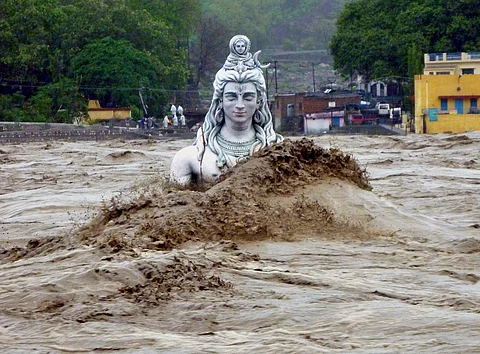

Even temples have to pass a test of faith. And when man stands between God, Nature, its fury and a temple structure, like in the rain-ravaged Kedarnath in Rudraprayag district, he pays the price. In the tragic and furious series of destruction at 3584 feet, the ancient temple, a sturdy symbol of faith of millions has gone unscathed. Today, Kedarnath has turned into a graveyard of slush and mud. A part of the temple lied buried in slush.
On the fateful night of July 16, around 13,000 pilgrims were in Kedarnath embarking on a difficult journey to the Jyotirlinga in the Char Dham Yatra to visit the Holy Shrine, the abode of Lord Shiva built by Adi Shankaracharya 1,200 years ago. Hundreds of devotees were outside the ancient temple.
The rains got heavier. Lashes turned into torrents. But wearing their brave faith and wispy transparent raincoats, the devotees waited for their turn to offer the prayers. A flash flood struck from behind the temple. Devotees got scattered. Many got washed away. Around hundred devotees huddled with each other in temple premises where they are never allowed to stay after the darshan is over. “Priests had sent out warnings, saying there were torrential rains and a danger of flash floods lurking in the area. The word reached had the devotees. But because there were more than 13,000 devotees on the route, no one could figure out how avert the danger. But the administration did not care to take any precautionary measures,” says Rakesh Raturi, from Joshimatth who is helping survivors stranded in Joshiomatth, Gangotri and other affected areas with food and shelter through a network of people.
There was a gap of 12 hours between the first flash flood and the one that struck Kedarnath at 6.55 am. A cloud burst and a flash flood broke the hell loose on Gandhi Taal, a lake 2 km from the Kedarnath Shrine. Locals say they had seen a rock, as high as the temple being broken from Kedar Dome, one of the two main mountains in the Gangotri Group of peaks getting stuck behind the temple. That directed the flashfloods towards the shrine and downstream, washing away devotees. Many others did not even get the time to respond. “Kedarnath has borne the brunt of the tragedy. It has been pushed 50 years back.
The death estimate in Kedarnath is numbing and depressing. I fear 15,000 people are missing, buried or dead by now,” says a Rashtria Swayam Sevak Sangh volunteer over the phone from Uttarkashi. Today Kedarnath presents the same picture it used to 60 years ago. The temple stood the test. “Bhagwan ki pratishthaa ka sawaal thha (It was the question of Shiva’s own prestige),” said a priest rescued from the temple, commenting on how the Temple withstood the floods and fury when the rest lies perished.
Was it Nature’s will to send Kedarnath back the clock by five decades. Or Shiva’s?